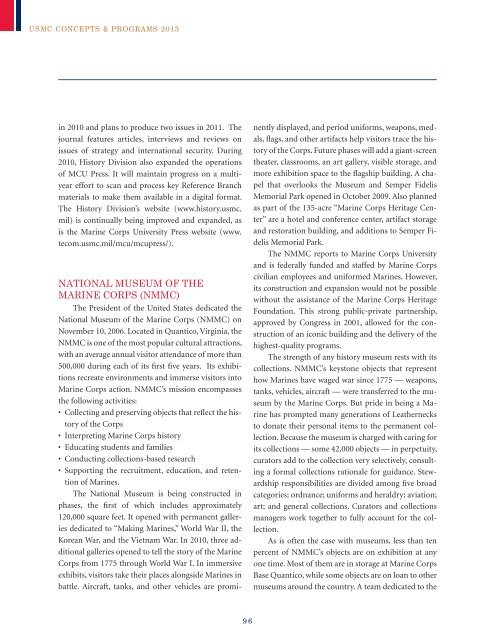USMC Concepts & Programs 2013 - Defense Innovation Marketplace
USMC Concepts & Programs 2013 - Defense Innovation Marketplace
USMC Concepts & Programs 2013 - Defense Innovation Marketplace
You also want an ePaper? Increase the reach of your titles
YUMPU automatically turns print PDFs into web optimized ePapers that Google loves.
<strong>USMC</strong> <strong>Concepts</strong> & <strong>Programs</strong> <strong>2013</strong><br />
in 2010 and plans to produce two issues in 2011. The<br />
journal features articles, interviews and reviews on<br />
issues of strategy and international security. During<br />
2010, History Division also expanded the operations<br />
of MCU Press. It will maintain progress on a multiyear<br />
effort to scan and process key Reference Branch<br />
materials to make them available in a digital format.<br />
The History Division’s website (www.history.usmc.<br />
mil) is continually being improved and expanded, as<br />
is the Marine Corps University Press website (www.<br />
tecom.usmc.mil/mcu/mcupress/).<br />
NATIONAL MUSEUM OF THE<br />
MARINE CORPS (NMMC)<br />
The President of the United States dedicated the<br />
National Museum of the Marine Corps (NMMC) on<br />
November 10, 2006. Located in Quantico, Virginia, the<br />
NMMC is one of the most popular cultural attractions,<br />
with an average annual visitor attendance of more than<br />
500,000 during each of its first five years. Its exhibitions<br />
recreate environments and immerse visitors into<br />
Marine Corps action. NMMC’s mission encompasses<br />
the following activities:<br />
• Collecting and preserving objects that reflect the history<br />
of the Corps<br />
• Interpreting Marine Corps history<br />
• Educating students and families<br />
• Conducting collections-based research<br />
• Supporting the recruitment, education, and retention<br />
of Marines.<br />
The National Museum is being constructed in<br />
phases, the first of which includes approximately<br />
120,000 square feet. It opened with permanent galleries<br />
dedicated to “Making Marines,” World War II, the<br />
Korean War, and the Vietnam War. In 2010, three additional<br />
galleries opened to tell the story of the Marine<br />
Corps from 1775 through World War I. In immersive<br />
exhibits, visitors take their places alongside Marines in<br />
battle. Aircraft, tanks, and other vehicles are prominently<br />
displayed, and period uniforms, weapons, medals,<br />
flags, and other artifacts help visitors trace the history<br />
of the Corps. Future phases will add a giant-screen<br />
theater, classrooms, an art gallery, visible storage, and<br />
more exhibition space to the flagship building. A chapel<br />
that overlooks the Museum and Semper Fidelis<br />
Memorial Park opened in October 2009. Also planned<br />
as part of the 135-acre “Marine Corps Heritage Center”<br />
are a hotel and conference center, artifact storage<br />
and restoration building, and additions to Semper Fidelis<br />
Memorial Park.<br />
The NMMC reports to Marine Corps University<br />
and is federally funded and staffed by Marine Corps<br />
civilian employees and uniformed Marines. However,<br />
its construction and expansion would not be possible<br />
without the assistance of the Marine Corps Heritage<br />
Foundation. This strong public-private partnership,<br />
approved by Congress in 2001, allowed for the construction<br />
of an iconic building and the delivery of the<br />
highest-quality programs.<br />
The strength of any history museum rests with its<br />
collections. NMMC’s keystone objects that represent<br />
how Marines have waged war since 1775 — weapons,<br />
tanks, vehicles, aircraft — were transferred to the museum<br />
by the Marine Corps. But pride in being a Marine<br />
has prompted many generations of Leathernecks<br />
to donate their personal items to the permanent collection.<br />
Because the museum is charged with caring for<br />
its collections — some 42,000 objects — in perpetuity,<br />
curators add to the collection very selectively, consulting<br />
a formal collections rationale for guidance. Stewardship<br />
responsibilities are divided among five broad<br />
categories: ordnance; uniforms and heraldry; aviation;<br />
art; and general collections. Curators and collections<br />
managers work together to fully account for the collection.<br />
As is often the case with museums, less than ten<br />
percent of NMMC’s objects are on exhibition at any<br />
one time. Most of them are in storage at Marine Corps<br />
Base Quantico, while some objects are on loan to other<br />
museums around the country. A team dedicated to the<br />
96

















